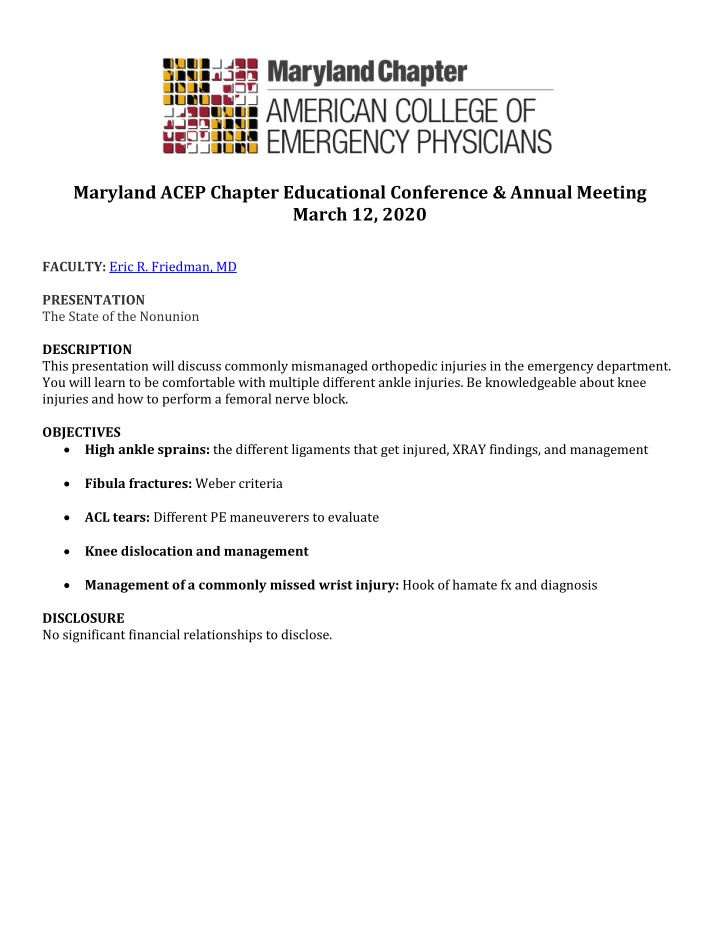



Maryland ACEP Chapter Educational Conference & Annual Meeting March 12, 2020 FACULTY: Eric R. Friedman, MD PRESENTATION The State of the Nonunion DESCRIPTION This presentation will discuss commonly mismanaged orthopedic injuries in the emergency department. You will learn to be comfortable with multiple different ankle injuries. Be knowledgeable about knee injuries and how to perform a femoral nerve block. OBJECTIVES • High ankle sprains: the different ligaments that get injured, XRAY findings, and management • Fibula fractures: Weber criteria • ACL tears: Different PE maneuverers to evaluate • Knee dislocation and management • Management of a commonly missed wrist injury: Hook of hamate fx and diagnosis DISCLOSURE No significant financial relationships to disclose.
The State of the Nonunion By Eric Friedman
Facts • 206 bones in the human body • All of them are capable of breaking
High Ankle Sprain • 25k ankle sprain per day in EDs (including low ankle sprain)
High Ankle Sprains • Syndesmotic membrane injury • Symptoms • Anterolateral ankle pain proximal to AITFL • May have medial sided ankle tenderness/swelling • More difficulty bearing weight than normal lateral ankle sprains • Physical Exam • Syndesmosis Tenderness (best predictor of return to play) • Squeeze Test
Maisonneuve Fracture
Case • Volleyball player landed and rolled ankle • TTP of lateral malleolus • XRAY: Fibular Fracture
Weber Criteria • Isolated distal fibular fractures • Weber A: below the level of the syndesmosis • Weber B at level of the syndesmosis, need stress view to determine stability • Weber C: above the level of the syndesmosis, unstable • Any bimalleolar (or trimalleolar) fracture is unstable
Weber A • Non-op • Stable
Weber B • Need to do a stress view and look for medial widening • >4-5 mm of medial clear space widening → surgery
Weber C • Unstable and needs surgery
Case • 25 yo M presents with right knee pain • He planted and twisted to cut and felt pain • Exam: rt knee edema
• Segund Fracture • Fracture of the lateral tibial condyle of the knee
ACL tears • Acute hemarthrosis • More common in females • ACL is the most commonly injured ligament in the body for which surgery is frequently performed • MCL is most common ligament torn • Usually noncontact when cutting and pivoting
Physical Exam • Lachman test: Place the patient's knee in about 20-30 degrees flexion, stabilize femur and anteriorly translate tibia. • Positive test: >2mm of anterior translation compared to the uninvolved knee and/or 10mm of anterior translation. • Sensitivity: ~84% Specificity: ~94% • Anterior Drawer test: knees flexed to 90 degrees and feet flat, grab the proximal lower leg, just below the tibiofemoral joint line, and translate the lower leg anteriorly • Positive test: lack of end feel or excessive anterior translation relative to the contralateral side • Sensitivity: ~73% Specificity: 93% • Lelli test/Lever sign • Sensitivity: 100% Specificity 100% • Repeat study Sensitivity: 63% Specificity 90% (worse than Lachman and anterior drawer in study)
Why Does All This Matter in the ED?
Another Case
Nurse Calls
Relocated
Another Case • Golfer with rt. wrist pain
Exam
Hook of Hamate Fracture • Seen in golfers and baseball players • Physical Exam: • TTP of the hamate bone in the hypothenar eminence • Decreased grip strength Hook of hamate pull test: hand held in ulnar deviation as patient flexes DIP joints of 4 th and 5 th digits • • Treatment • Splint (short arm splint) • Surgical Removal (quicker return to play)
References • https://www.orthobullets.com/trauma/1037/femoral-neck-fractures • https://www.ncbi.nlm.nih.gov/pubmed/28759316 • https://www.orthobullets.com/foot-and-ankle/7029/high-ankle-sprain-and- syndesmosis-injury • https://coreem.net/core/ankle-stress-views/ • https://www.ncbi.nlm.nih.gov/pmc/articles/PMC5639970/ • https://www.ncbi.nlm.nih.gov/pubmed/25536951 • https://www.rch.org.au/clinicalguide/guideline_index/Femoral_Nerve_Block/
Recommend
More recommend